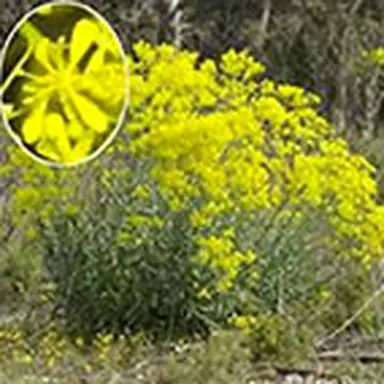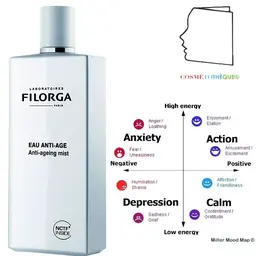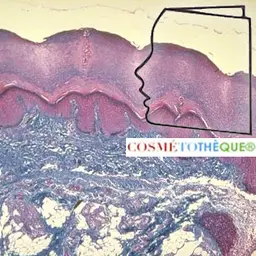
We are at the end of the 80s, the problem of polyunsaturated fatty acids (PUFA) continues to make the news in food and is beginning to be a certain subject in cosmetics. Many sources for these substances are proposed, and some work is beginning to clarify their role at the skin level, whereas their interest at that time was more specifically described at the dietary level. It is at this time that a banal information appeared in the regional press reports that a Toulouse team is working to reintroduce pastel culture in their region.
This article from La Dépêche du Midi of 27 August 1987 described the ancestral uses of this plant, such as pastel leaf poultices, but also the possibility of obtaining from seeds an oil particularly rich in EFA, and more specifically in a fatty acid little documented at the time, Omega 3. One of the emblematic products of the Bourjois brand has always been, and still is today, the name of Pastel Blush . The conjunction of these two elements has led us to focus on the use of pastel derivatives in cosmetic products in general.
What is pastel?
According to Wikipedia The pastel of the dyers or suede ( Isatis tinctoria L.) is a biennial herbaceous plant of the family Brassicaceae from Central Asia, South-West Asia and South-East Europe. It is also known by the vernacular names of Grass of Saint Philippe , Varède or even Lauragais grass . Used as a medicinal and dyeing plant by the ancient Greeks and Romans, it was widely cultivated during the Middle Ages and the Renaissance. In Europe, it allowed the production of a blue dye, extracted from the leaves, before it was dethroned by the indigo tree, then by synthetic dyes.
The pastel blue dye is extracted from the leaves of the plant. In Lauragais, until the 17th century, the entire extraction process of the coloured pigment took place over two years. - The first year, pastel producers grew the plant. The leaves were picked by hand from Saint John's Day to All Saints' Day. Carefully washed, they were crushed with a paste mill. The mill was a simple stone millstone that turned in a trough and transformed the leaves into a mush that was prepared into balls, called"cocagnes". These cocagnes, hardened and dried in suitable dryers, were then sold to local collectors, intermediaries between the producers and the powerful pastel merchants of Toulouse. - In the second year, the pastel merchants produced the dye powder (or agranate). , i.e. the material intended to be used in the tanks of the dyers.
In his A short history of pastel Jean Odol reports that "the "pastel flower", collected on the edge of the tanks of the dyers, was also used as pigment for the Fine Arts, and also by the "painters" (name given at the time to designate the painters of the carriages and buildings) under the name of blue charron)".
The manufacture of the pigment and its use by dyers was well known. Indeed, the dyers' corporation was highly regulated and left many documents on pigments and color manufacturing. It is a little different from the use by painters, because their corporation practically did not exist. The secrets of the workshops on painting processes were only partially unveiled in the Enlightenment, with the publication in 1788 of the first"Traité de la peinture au pastel" by Paul-Romain de Chaperon.
This plant was particularly well known in Europe in the Toulouse region, where it became rich in the Middle Ages and was considered a true'blue gold'. The rich pastry merchants of Toulouse also owned farms and granted loans to small farmers. The supply of pigment from Asia was to ruin this industry, which will gradually disappear in the Toulouse region.
By focusing on local resources, the Institut National Polytechnique de Toulouse now a CRITT had identified the interest of this plant for the region. In collaboration with Magrin Castle the Pastel Museum on the Route du Pastel In the course of his work, he tried to find pastels seeds to see to what extent it was possible to reintroduce the cultivation of this shrub in the region. This was done. The process is significantly different from that of the time. It is currently sown in August, flowers in April and is harvested in June. Once again having sufficient biomass, the organism was able to carry out exhaustive research on this plant to characterise its interest. It is at the end of this research that the presence of a particular oil in the seeds was highlighted.
The project, developed in partnership with this organization, consisted in reintroducing the culture of pastel in sufficient quantities to produce oil of first pressure, with the aim of using it in these cosmetic products. The technicians who led this project, Christine Lauth and Olivier Thierry, will tell you the main episodes of this exciting project in an article to come : The rebirth of pastel thanks to cosmetics .
Cosmetic use
Classically, the use of vegetable oils in cosmetics responded to rather classical considerations such as the emollient effect, lubricant or the moisturizing effect common to all vegetable oils because of their semi-occlusive character.
At the same time, there was growing interest in the role of EFAs or PUFAs. Indeed, the particular role of ceramides in the skin was becoming clearer, and the involvement of essential fatty acids in the constitution of acyl ceramides was becoming more and more important. However, the focus was on Omega 6 rather than balanced PUFA blends. Finally, skin sensitivity traits were beginning to become a particular focus of interest.
It was for these reasons that the use of a highly unsaturated oil made sense. We then approached the use of these oils from different angles: - as an ingredient on its own, - as a balanced blend of polyunsaturated fatty acids (PUFAs). In both cases, the idea was to provide components to corneocyte cohesion factors to improve skin hydration, reinforce the barrier effect and compensate for skin sensitivity characteristics.
To support this dossier, some work was carried out in collaboration with the CED (Centre Européen de Dermocosmétologie - Lyon) to show that topical application of pastel oil could modify the skin's response and improve its appearance. This is how we were interested in the evaluation of the occlusivity of the oil, the effect on desquamation, the restructuring activity by evaporation, the"anti-inflammation" effect with respect to erythema installed under UV or by UV induction of erythema, the effect on elasticity, etc. in vivo the comparison of the healing effect of inflammation compared to other vegetable oils. The results were presented at an international congress on the use of pastel.
The overall results were sufficient proof of concept to consider the introduction of this oil in different preparations. A patent on the use of a balanced blend of essential fatty acids made with pastel oil has been filed (Patent No. 2 681 783 - Lauth Christine, Le Joliff Jean-Claude, Thierry Olivier).
These different approaches took the form of commercial products that were launched under the Bourjois and Chanel brands respectively. The Bourjois product was entitled Secret complexion . It was a foundation to improve hydration and protect the skin while developing a make-up effect. In a way a predecessor of the foundations and BB Cream that make the news today. Chanel products have entered the range Continuous Nutrition Cream and Emulsion for alipique and mature skins. The dosage of the oily complex significantly improved the hydration characteristics and decreased the roughness of the dry skin characteristics. These various products, in particular Chanel products, were commercially exploited until the end of the 1990s.
In the following articles, we will return in detail on the characteristics of pastel oil, then on its current use, either in the context of craft activity (Bleu de Lectoure) or in current cosmetic uses: Graine de Pastel® among others. And a few more.
Enjoy your reading.
| Contribution made by Jean Claude Le Joliff A biologist by training, Jean Claude Le Joliff was a man of R&D for many years. Successively in charge of R&D, then of Research and Innovation in a large French cosmetics and luxury group, and after an experience of creating a research centre (CERIES), he turned to innovation management. He is the founder of inn2c, an R&D and Innovation consulting company. Consultant to several international companies, he has actively participated in projects such as Filorga, Aïny, Fareva, and many others. He created the Cosmétothèque®, the industry's first conservatory of crafts and know-how. |













